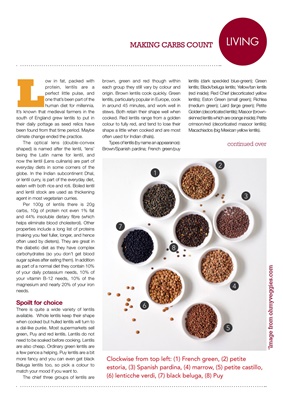
LIVING
continued over
Low in fat, packed with
protein, lentils are a
perfect little pulse, and
one that's been part of the
human diet for millennia.
It's known that medieval farmers in the
south of England grew lentils to put in
their daily pottage as seed relics have
been found from that time period. Maybe
climate change ended the practice.
The optical lens (double-convex
shaped) is named after the lentil, 'lens'
being the Latin name for lentil, and
now the lentil (Lens culinaris) are part of
everyday diets in some corners of the
globe. In the Indian subcontinent Dhal,
or lentil curry, is part of the everyday diet,
eaten with both rice and roti. Boiled lentil
and lentil stock are used as thickening
agent in most vegetarian curries.
Per 100g of lentils there is 20g
carbs, 10g of protein not even 1% fat
and 44% insoluble dietary fibre (which
helps eliminate blood cholesterol).
Other properties include a long list of
proteins (making you feel fuller, longer,
and hence often used by dieters) and
complex carbohydrates (so you don't get
blood sugar spikes after eating them).
In addition as part of a normal diet they
contain 10% of your potassium needs,
10% of your vitamin B-12 needs, 10% of
the magnesium and nearly 20% of your
iron needs.
Spoilt for choice
There is quite a wide variety of lentils
available. Whole lentils keep their shape
when cooked but hulled lentils will turn to
a dal-like purée. Most supermarkets sell
green, Puy and red lentils. Lentils do not
need to be soaked before cooking. Lentils
are also cheap. Ordinary green lentils are
a few pence a helping. Puy lentils are a bit
more fancy and you can even get black
Beluga lentils too, so pick a colour to
match your mood if you want to.
The chief three groups of lentils are
brown, green and red though within
each group they still vary by colour and
origin. Brown lentils cook quickly. Green
lentils, particularly popular in Europe, cook
in around 45 minutes, and work well in
stews. Both retain their shape well when
cooked. Red lentils range from a golden
colour to fully red, and tend to lose their
shape a little when cooked and are most
often used for Indian dhals).
Types of lentils (by name an appearance):
Brown/Spanish pardina; French green/puy
MAKING CARBS COUNT
lentils (dark speckled blue-green); Green
lentils; Black/beluga lentils; Yellow/tan lentils
(red inside); Red Chief (decorticated yellow
lentils); Eston Green (small green); Richlea
(medium green); Laird (large green); Petite
Golden (decorticated lentils); Masoor (brownskinned lentils which are
orange inside); Petite
crimson/red (decorticated masoor lentils);
Macachiados (big Mexican yellow lentils).